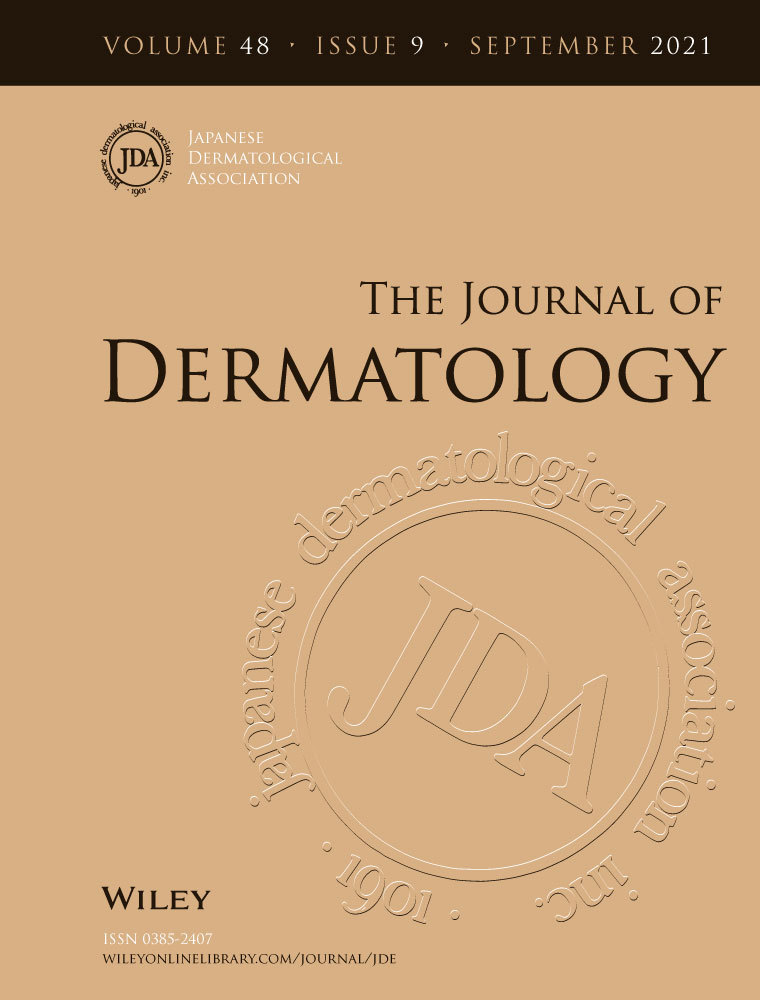Unique cutaneous features in a case of anti-nuclear matrix protein 2 antibody positive-dermatomyositis
Kaori Shima
Department of Dermatology, Kyoto University Graduate School of Medicine Faculty of Medicine, Kyoto, Japan
Search for more papers by this authorCorresponding Author
Saeko Nakajima
Department of Dermatology, Kyoto University Graduate School of Medicine Faculty of Medicine, Kyoto, Japan
Correspondence
Saeko Nakajima, Department of Dermatology, Graduate School of Medicine Faculty of Medicine, Kyoto University, 54 Shogoin Kawahara, Sakyo, Kyoto 606-8507, Japan.
Email: [email protected]
Search for more papers by this authorShunya Usui
Department of Dermatology, Kyoto University Graduate School of Medicine Faculty of Medicine, Kyoto, Japan
Search for more papers by this authorKosaku Murakami
Department of Rheumatology and Clinical Immunology, Kyoto University Graduate School of Medicine Faculty of Medicine, Kyoto, Japan
Search for more papers by this authorKenji Kabashima
Department of Dermatology, Kyoto University Graduate School of Medicine Faculty of Medicine, Kyoto, Japan
Singapore Immunology Network (SIgN) and Skin Research Institute of Singapore (SRIS), Agency for Science, Technology and Research (A*STAR, Singapore, Singapore
Search for more papers by this authorKaori Shima
Department of Dermatology, Kyoto University Graduate School of Medicine Faculty of Medicine, Kyoto, Japan
Search for more papers by this authorCorresponding Author
Saeko Nakajima
Department of Dermatology, Kyoto University Graduate School of Medicine Faculty of Medicine, Kyoto, Japan
Correspondence
Saeko Nakajima, Department of Dermatology, Graduate School of Medicine Faculty of Medicine, Kyoto University, 54 Shogoin Kawahara, Sakyo, Kyoto 606-8507, Japan.
Email: [email protected]
Search for more papers by this authorShunya Usui
Department of Dermatology, Kyoto University Graduate School of Medicine Faculty of Medicine, Kyoto, Japan
Search for more papers by this authorKosaku Murakami
Department of Rheumatology and Clinical Immunology, Kyoto University Graduate School of Medicine Faculty of Medicine, Kyoto, Japan
Search for more papers by this authorKenji Kabashima
Department of Dermatology, Kyoto University Graduate School of Medicine Faculty of Medicine, Kyoto, Japan
Singapore Immunology Network (SIgN) and Skin Research Institute of Singapore (SRIS), Agency for Science, Technology and Research (A*STAR, Singapore, Singapore
Search for more papers by this authorCONFLICT OF INTEREST
None declared.
REFERENCES
- 1Espada G, Maldonado Cocco JA, Fertig N, Oddis CV. Clinical and serologic characterization of an Argentine pediatric myositis cohort: identification of a novel autoantibody (anti-mj) to a 142-kda protein. J Rheumatol. 2009; 36: 2547–51.
- 2Li D, Tansley SL. Juvenile dermatomyositis — Clinical phenotypes. Curr Rhumatol Rep. 2019; 21: 74–81.
- 3DeWane ME, Waldman R, Lu J. Dermatomyositis: clinical features and pathogenesis. J Am Acad Dermatol. 2020; 82: 267–81.
- 4Rogers A, Chung L, Li S, Casciola-Rosen L, Fiorentino DF. Cutaneous and systemic findings associated with nuclear matrix protein 2 antibodies in adult dermatomyositis patients. Arthritis Care Res. 2017; 69: 1909–14.
- 5Inoue S, Okiyama N, Shobo M, et al. Diffuse erythema with ‘angel wings’ sign in Japanese patients with anti-small ubiquitin-like modifier activating enzyme antibody-associated dermatomyositis. Br J Dermatol. 2018; 179: 1414–5.




